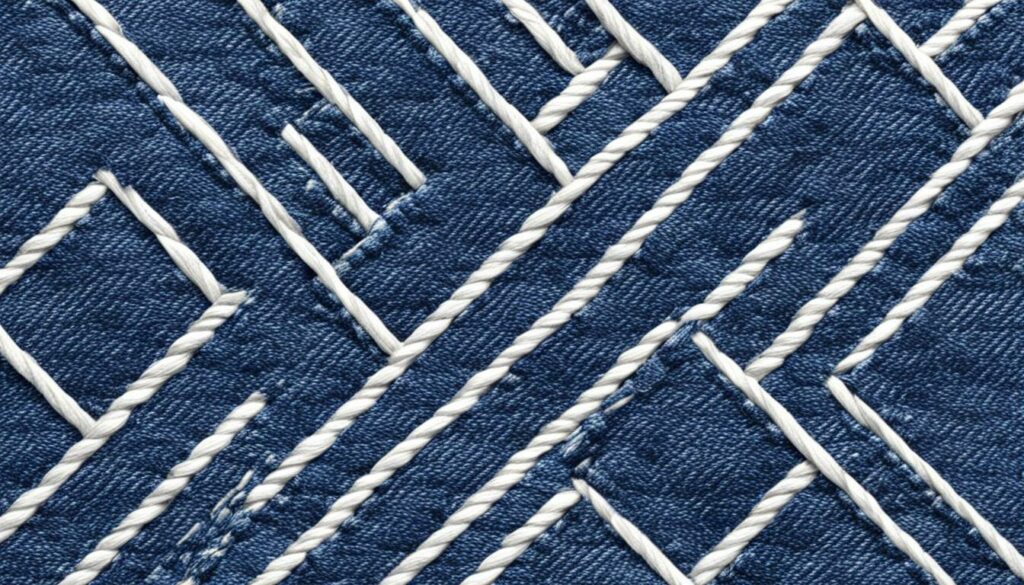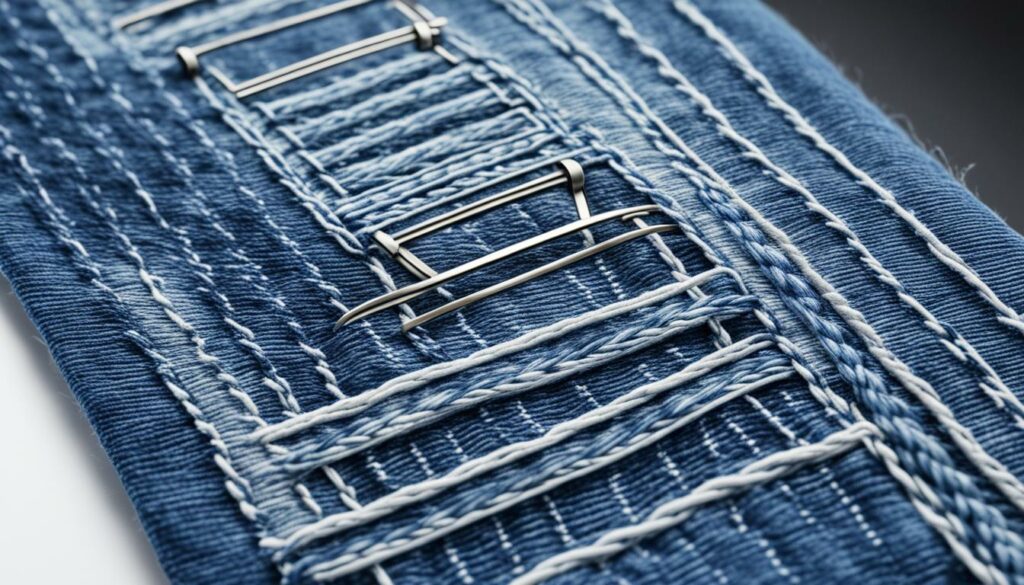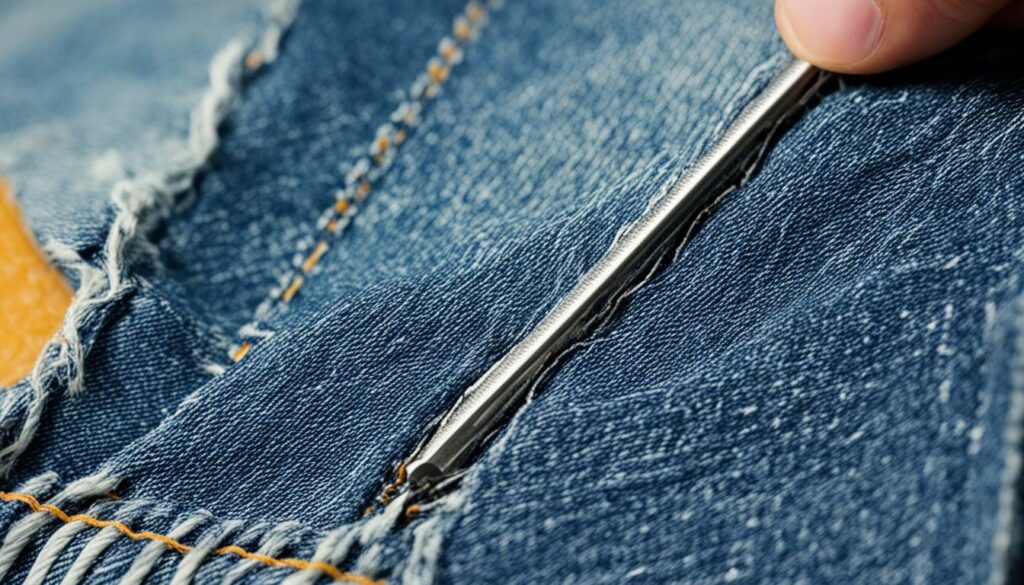
Denim and jeans are often used interchangeably, but they are not the same thing. Denim refers to a type of fabric, while jeans are a style of pants made from denim. Denim is a sturdy cotton twill fabric that is woven using a specific technique called selvage weaving, which creates a self-bound edge that cannot unravel. Jeans, on the other hand, are garments made from denim fabric and are typically characterized by their five-pocket design and riveted construction. Jeans can be made from both selvage and non-selvage denim, but selvage denim is often associated with higher quality and craftsmanship.
Key Takeaways:
- Denim is a fabric, while jeans are a style of pants made from denim.
- Denim is woven using selvage weaving, creating a self-bound edge that cannot unravel.
- Jeans are garments made from denim and are characterized by their five-pocket design and riveted construction.
- Jeans can be made from both selvage and non-selvage denim, with selvage denim often associated with higher quality.
- When choosing denim, consider factors such as durability, care instructions, and personal style preferences.
Understanding Selvage Denim
Selvage denim is a type of denim fabric that is highly sought after by denim enthusiasts for its unique characteristics. To fully appreciate selvage denim, it’s important to understand the weaving process, its aesthetics, and the factors that contribute to its durability.
Weaving Process: Shuttle Looms and Self-Bound Edges
Selvage denim is woven using traditional shuttle looms, which are known for their slower production speed compared to modern projectile looms. However, this slower process allows for the creation of a fabric with self-bound edges, also known as the selvage. The selvage edge is tightly woven and prevents fraying, giving the fabric added durability and stability. This distinctive edge can be seen when cuffs are rolled up, adding to the aesthetic appeal of selvage denim.
The shuttle loom weaving process involves passing the weft yarn back and forth between the warp yarns. This creates a tightly woven fabric with a more robust structure compared to denim produced using other weaving methods.
Durability and Longevity
One of the key advantages of selvage denim is its durability. The tightly woven selvage edge prevents the fabric from unraveling, contributing to the longevity of selvage denim garments. The high-quality construction and attention to detail in the weaving process make selvage denim particularly resistant to wear and tear, ensuring that it can withstand the test of time.
Aesthetics and Personal Style
Selvage denim is often prized for its aesthetic appeal. The visible selvage edge adds a unique touch to denim garments, especially when cuffs or hems are rolled up. This small detail can make a big difference in terms of personal style, allowing denim enthusiasts to showcase their appreciation for craftsmanship and attention to detail.
Selvage Denim vs. Non-Selvage Denim
While selvage denim is often associated with higher quality, it’s important to note that the selvage edge alone does not determine the durability or mechanical properties of the fabric. Non-selvage denim can also be of excellent quality, depending on factors such as the type of cotton used, the dyeing process, and the overall construction of the garment.
The choice between selvage and non-selvage denim ultimately comes down to personal preference and style. Some individuals prefer the unique aesthetic of selvage denim, while others may prioritize other factors such as price or availability. It’s essential to explore both options and consider factors beyond selvage when selecting denim that aligns with your preferences.
| Selvage Denim | Non-Selvage Denim |
|---|---|
| Produced using shuttle looms | Produced using various weaving methods |
| Has a self-bound edge (selvage) | Does not have a selvage edge |
| Visible selvage edge when cuffs are rolled up | No visible selvage edge |
| Prized for its aesthetic appeal | Aesthetics may vary depending on the fabric and construction |
| Can be associated with higher craftsmanship | Quality depends on various factors |
Caring for Denim Jeans
To ensure your denim jeans stay in great condition, proper care and maintenance are essential. By following a few simple steps, you can prevent fraying, extend their lifespan, and embrace the unraveled style if desired.
Choosing the Right Denim
When purchasing jeans, opt for pairs made of 100% denim rather than synthetic materials. Synthetic blends are more prone to fraying and may not withstand regular wear and tear as well as authentic denim.
Additionally, choosing the right fit is crucial for preventing damage. Jeans that are too big and constantly slide down can lead to fraying along the waistband and hems. Make sure to find the perfect fit to avoid unnecessary strain on the fabric.
Avoid Dragging and Follow Care Labels
Dragging your jeans on the ground not only exposes them to dirt and potential damage, but it also increases the likelihood of fraying along the edges. Be mindful of your jeans’ length and lift them if necessary, especially when walking on rough surfaces.
Furthermore, always follow the care labels provided by the manufacturer. Each pair of jeans may have specific instructions regarding washing, drying, and ironing. Adhering to these guidelines can help preserve the integrity of the denim fabric and prevent unnecessary fraying.
Invest in High-Quality Jeans
Investing in high-quality jeans can make a significant difference in their durability. Look for brands known for their craftsmanship and attention to detail. Well-made jeans are less likely to fray or develop loose threads over time.
If you notice any areas of your jeans that have already started to fray, consider patching them up to prevent further damage. This can be done using denim patches or by visiting a professional tailor who specializes in repairing denim garments.
Embrace the Unraveled Style
Denim fashion has embraced the distressed and unraveled look in recent years. If you prefer this style, there’s no need to worry about preventing fraying. In fact, you can intentionally create frayed edges or distress your jeans for a fashionable, worn-in appearance.

However, if you prefer a more polished look, it’s essential to take the necessary steps to prevent fraying and maintain the integrity of your jeans. By following these care tips, you can enjoy your denim jeans for years to come.
The History of Selvage Denim
The history of selvage denim can be traced back to the early 1900s when it became a popular choice for workwear due to its exceptional durability and strength. Selvage denim is known for its unique weaving technique and high-quality craftsmanship, making it a sought-after fabric for denim enthusiasts around the world.
One significant part of the history of American selvage denim is the Cone Mills White Oak plant in North Carolina. From 1905 until its closure in 2017, this iconic mill played a pivotal role in the production of American selvage denim. The Cone Mills White Oak plant was renowned for its commitment to quality and innovation, setting the standard for American denim manufacturing.
On the other side of the globe, Japanese selvedge denim has earned its own reputation for excellence. Brands like Kaihara Mill have been at the forefront of creating premium Japanese selvage denim fabrics. These fabrics are known for their attention to detail and superior craftsmanship, reflecting the Japanese dedication to creating the finest denim products.
The weaving process used in selvage denim is a key factor in its production. Shuttle looms, often referred to as vintage looms, are used to weave the fabric. These traditional looms create a tightly woven fabric with self-bound edges, known as selvage. The distinct selvage edge is an indicator of quality and authenticity in selvage denim.
Key Points:
- The history of selvage denim dates back to the early 1900s and was popularized as workwear.
- The Cone Mills White Oak plant in North Carolina was a significant producer of American selvage denim.
- Japanese selvedge denim, exemplified by brands like Kaihara Mill, is renowned for its craftsmanship.
- The weaving process in selvage denim involves the use of shuttle looms to create the distinct selvage edge.
The Benefits of Selvage Denim
Selvage denim offers numerous benefits that set it apart from other types of denim fabric. From its exceptional durability to its unique fading patterns, selvage denim is a favorite among denim enthusiasts and fashion connoisseurs alike.
Durability
One of the key advantages of selvage denim is its exceptional durability. The use of shuttle looms and the meticulous weaving process result in a tightly woven fabric that is more resistant to wear and tear. This means that selvage denim jeans are built to withstand the test of time, making them a long-lasting investment. You can enjoy your selvage denim jeans for years, confident in their ability to hold up to even the most rigorous activities.

Unique Fading Patterns
Another distinctive feature of selvage denim is its ability to develop unique fading patterns over time. The tightly woven fabric and raw, unwashed nature of selvage denim allow it to mold to the wearer’s body and lifestyle. As you wear your selvage denim jeans, the indigo dye will naturally fade, creating beautiful and personalized fading patterns that reflect your individual experience and style. This natural aging process gives selvage denim a unique character that cannot be replicated.
Connection to History and Craftsmanship
By choosing selvage denim, you become a part of a rich heritage and tradition rooted in craftsmanship. Selvage denim has strong ties to the history of denim production and the working class that relied on its durability. Wearing selvage denim pays homage to the artisans and craftsmen who have perfected the art of denim weaving over generations. It is a testament to their skill and dedication, bringing a sense of authenticity and connection to the past.
Superior Quality and Longevity
Selvage denim is renowned for its superior quality and longevity. The attention to detail in the production process, from the use of shuttle looms to the finishing touches, ensures that each pair of selvage denim jeans is crafted to the highest standards. The result is a garment that not only withstands daily wear and tear but also gets better with age. Selvage denim improves over time, developing a distinct patina and becoming uniquely yours.
Overall, selvage denim is a premium option for those seeking denim garments that offer exceptional durability, unique fading patterns, and a connection to the rich history of craftsmanship. Choosing selvage denim means investing in superior quality and longevity, allowing you to enjoy your jeans for years to come.
Conclusion
In summary, denim and jeans are distinct yet closely related. Denim is a versatile fabric, while jeans are a popular style of pants made from denim. Selvage denim, woven using shuttle looms, is often regarded for its superior quality and craftsmanship. However, the choice between selvage and non-selvage denim ultimately depends on personal preferences and style.
When deciding on the right denim, it is important to consider various factors. Selvage denim offers advantages like increased durability and unique fading patterns over time. On the other hand, non-selvage denim can still provide comfort and style at a more affordable price. Care instructions, fit, and individual preferences should also be taken into account.
Ultimately, choosing the right denim comes down to finding the perfect balance between aesthetic appeal, durability, and personal preferences. Whether you opt for selvage denim, non-selvage denim, or a blend of both, embracing the unique qualities of denim will ensure you find the ideal pair of jeans that not only align with your style but also stand the test of time.
FAQ
What is the difference between denim and jeans?
Denim refers to a type of fabric, while jeans are a style of pants made from denim.
What is selvage denim?
Selvage denim is a type of denim produced using shuttle looms, which create a self-bound edge that adds durability and stability to the fabric.
How can I prevent denim jeans from fraying?
To prevent fraying, choose jeans made of 100% denim, avoid dragging them on the ground, and follow the care instructions on the garment’s label. Investing in high-quality jeans and patching damaged areas can also help.
What is the history of selvage denim?
Selvage denim has a rich history dating back to the early 1900s when it was commonly used for workwear. The Cone Mills White Oak plant in North Carolina played a significant role in the production of American selvage denim.
What are the benefits of selvage denim?
Selvage denim offers increased durability and unique fading patterns over time. It also provides a connection to the history of craftsmanship and the artisans who produce it.
How do I choose the right denim for my needs?
Whether you choose selvage denim or non-selvage denim, consider factors like durability, care instructions, and fit when selecting the right denim for your needs.
